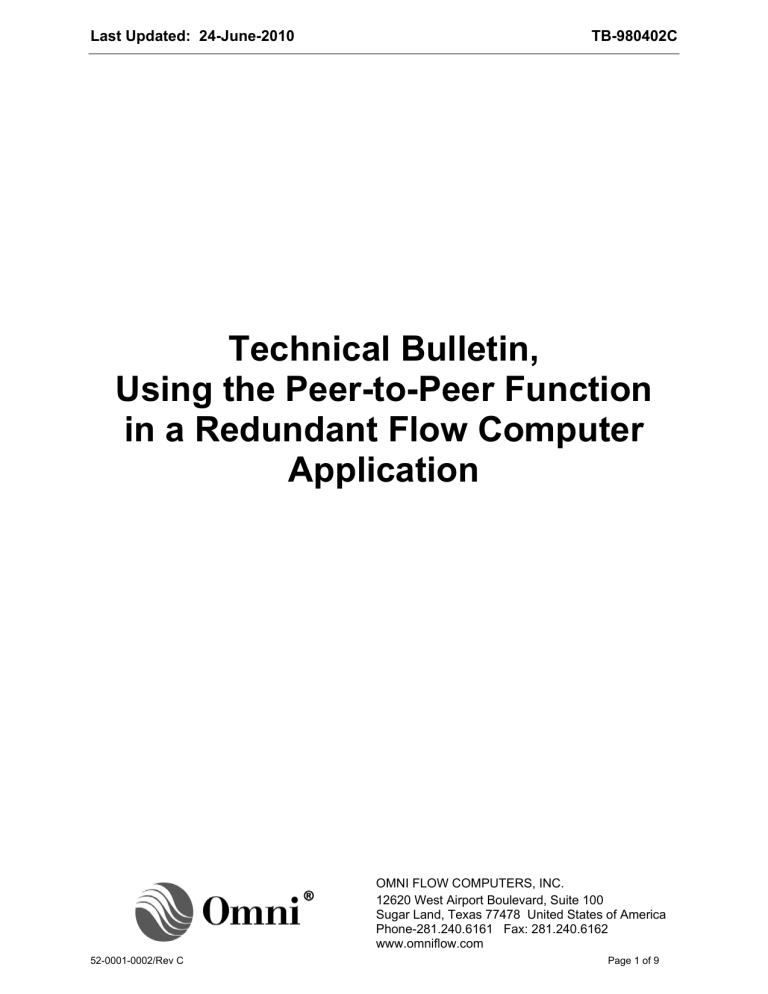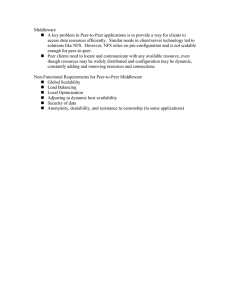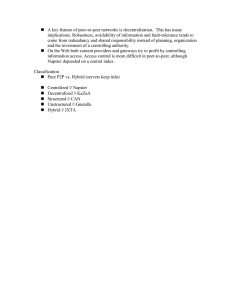Using the Peer-to-Peer Function in a Redundant Flow Computer

Last Updated: 24-June-2010 TB-980402C
Technical Bulletin,
Using the Peer-to-Peer Function in a Redundant Flow Computer
Application
52-0001-0002/Rev C
OMNI FLOW COMPUTERS, INC.
12620 West Airport Boulevard, Suite 100
Sugar Land, Texas 77478 United States of America
Phone-281.240.6161 Fax: 281.240.6162 www.omniflow.com
Page 1 of 9
TB-980402C Using the Peer-to-Peer Function in a
Redundant Flow Computer Application
NOTES: User Manual Reference – This Technical Bulletin complements the information contained in
User Manual, and is applicable to all firmware revisions Versions .74+.
This is an updated edition of the bulletin previously published under the same title.
Peer-to-Peer Redundancy Schemes – Redundancy schemes allow for uninterruped measurement and control functionality by interconnecting two identically equipped and configured flow computers.
Table of Contents
Scope.......................................................................................................................................... 3
Abstract....................................................................................................................................... 3
RS-232-C Wiring Requirements ................................................................................................. 3
RS-485 Wiring Requirements ..................................................................................................... 4
Setting Up the Peer-to-Peer for Redundant Flow Computer Applications .................................. 4
Sensing Failures and Switching Between Redundant Computers.............................................. 5
Changing the Master / Slave Status via a Modbus Serial Port ................................................... 6
Redirecting the Control Signals .................................................................................................. 7
Sharing Input Signals Between Primary and Secondary Flow Computers ................................. 7
Re-Calibration of Analog Inputs .................................................................................................. 7
Sharing Digital I/O Signals Between Primary and Secondary Flow Computers ......................... 7
Redundant Flow Computer Configuration................................................................................... 8
Defining which Computer will be the Master or Primary Computer at Power Up* ...................... 8
Figures
Figure 1. OMNI 6000 (3000) Peer-to-Peer Wiring Requirements ................................................3
Figure 2. OMNI 6000 (3000) Peer-to-Peer Wiring Requirements ...............................................4
Figure 3. OMNI 6000 / 3000 Redundancy Failover Wiring ..........................................................6
52-0001-0002/Rev C
Page 2 of 9
TB-980402C Using the Peer-to-Peer Function in a
Redundant Flow Computer Application
Scope
All firmware revisions Versions .74+ of OMNI 6000/OMNI 3000 Flow Computers have the Peer-to-Peer
Communications feature, which is available only on Serial Port #2. This feature includes the capability of setting-up redundant flow computer schemes.
Abstract
Redundancy involves using two identically equipped flow computers and connecting them in such a way to ensure uninterrupted measurement and control functionality in the event of failure of one of the units.
This requires that all input and output signals are connected to both computers. During normal operation, one computer is designated the primary and the other computer the secondary or backup. To ensure synchronization between both devices, important variables such as PID controller settings, control valve positions and proving meter factors must be transmitted from the primary flow computer via the peer-topeer link to the secondary flow computer. Should a failure of the primary flow computer occur, the secondary flow computer is automatically promoted to primary and assumes all control and measurement functions. In this case the data flow on the peer-to-peer link reverses automatically and the new master begins to transmit critical data to the slave, assuming that it is functioning. Peer-to-peer communication errors can occur during the switch over and are normal. They are cleared by pressing the [Ack] key on the flow computer keypad or writing to point 1712 (acknowledge station alarms). If the other flow computer is non-operational, the peer-to-peer communication errors cannot be cleared.
RS-232-C Wiring Requirements
Figure 1 shows the wiring needed when flow computers are applied in a redundancy scheme via the peer-to-peer feature and using the proprietary RS-232/RS485 Serial I/O Module Model # 68-6205. They are connected in a two-wire multi-drop mode.
NOTE: Jumper between 7 and 8 on the second unit is required to allow users to monitor master/slave alarm status and to allow continued Peer/Peer communications after power is restored to any failed unit.
Omni #1
TB3
(TB2)
Omni #2
TB3
(TB2)
4
5
6
1
2
3
7
8
9
10
4
5
6
1
2
3
7
8
9
10
11
12
11
12
Figure 1. OMNI 6000 (3000) Peer-to-Peer Wiring Requirements
52-0001-0002/Rev C
Page 3 of 9
TB-980402C Using the Peer-to-Peer Function in a
Redundant Flow Computer Application
RS-485 Wiring Requirements
Figure 2 shows the wiring needed when flow computers are applied in a redundancy scheme via the peer-to-peer feature and using the proprietary RS-232/485 Serial I/O Module Model # 68-6205. They are connected in a multidrop mode using the RS-485 two-wire termination option.
Omni #1
TB3
(TB2)
1
2
3
4
5
6
(B)
7
8
9
10
11
(A)
12
Omni #2
TB3
(TB2)
1
2
3
4
5
6
7
8
(B)
9
10
(A)
11
12
RS-485 Two-wire
Terminated
RS-485 Two-wire
Terminated
Figure 2. OMNI 6000 (3000) Peer-to-Peer Wiring Requirements
Setting Up the Peer-to-Peer for Redundant Flow Computer Applications
The ‘Activate Redundancy Mode’ entry is found in the peer-to-peer setup menu. Answering ‘Yes’ causes the ‘Next Master’ and ‘Last Master’ entries to disappear from the menu. They no longer need to be entered as the two flow computers now manage these two entries automatically. Any data needing to be synchronized between the flow computers will need to be setup by the user as transactions in the peer-topeer menu.
“Use this OMNI as the default master entry?” allows the user to select which OMNI will be the master on power up of both flow computers. (Selection is only available on firmware xx.74.30 and higher)
NOTE : Transactions #1 and #2 – Both primary and secondary flow computers must have these entries if they will be used for PID control;
Transaction #1: Sends the primary flow computer PID control mode settings (Auto/Manual,
Local/Remote) to the secondary flow computer.
Transaction #2: Sends the primary flow computer PID set Points and valve position values to the secondary flow computer.
Two transactions are needed to handle redundant PID control:
Transaction #1 Target Slave ID
Read/Write ?
Source Point #
NO of Points
Destination Pnt #
Transaction #2 Target Slave ID
Read/Write ?
Source Point #
NO of Points
Destination Pnt #
2
W
13462
8
13470
2
W
7601
20
7601
52-0001-0002/Rev C
Page 4 of 9
TB-980402C Using the Peer-to-Peer Function in a
Redundant Flow Computer Application
More peer-to-peer transactions are needed if additional data needs to be transferred, such as accepted proved meter factors for example.
Transaction #3 Target Slave ID
Read/Write ?
Source Point #
NO of Points
Destination Pnt #
2
W
5113
1
5113
Transaction #4 Target Slave ID
Read/Write ?
Source Point #
NO of Points
Destination Pnt #
2
W
5137
1
5137
Modbus address 5137 (Retro Bbls) needs to be entered in each flow computer as #9999999 so that the downloaded new Meter Factor can be retroactively applied back to the batch start.
Flow computers containing firmware Revisions 22 or 26 handle meter factor implementation differently than Revisions 20 or 24. These applications maintain historical meter factor entries which are triggered and stored when the meter factor is accepted and implemented at the end of a meter proving. As only the primary flow computer will be doing the actual proving, three special variables with associated firmware code have been added to the data base of revisions 22 and 26. By writing to and reading from these variables via the peer-to-peer link, the secondary flow computer can implement the meter factor result obtained when the primary computer completes and accepts a prove result.
NOTE : Transactions #3 and #4 – (Applicable to Firmware Versions 22 & 26 Only) – Both primary and secondary flow computers mush have these entries.
Transaction #3: Used to send the prove meter factor (5904) and the number of the meter last proved (5905) to the secondary flow computer.
Transaction #4: Confirms that the meter factor has been implemented in the secondary flow computer by reading back a copy of the number of the meter run just proved (5906).
The following two transactions are required:
Transaction #3
Transaction #4
Target Slave ID
Read/Write ?
Source Point #
NO of Points
Destination Pnt #
Target Slave ID
Read/Write ?
Source Point #
NO of Points
Destination Pnt #
2
W
5904
2
5904
2
R
5906
1
5906
Sensing Failures and Switching Between Redundant Computers
NOTE: Setting Up Peer-to-Peer Transactions – For each transaction, the flow computer requires the following data (TB 980401 “Peer-to-Peer Basics):
Target Slave ID: Modbus database address of target device.
Read/Write?: ‘Read (R) selects slave as source device and master as destination device.
‘Write’ (W) selects master as source device and slave as destination device.
Source Point #: Specifies database address (or first address in sequence) of data to transfer from source to destination device.
# of Points: Total number of consecutive database addresses in sequence to transfer.
52-0001-0002/Rev C
Page 5 of 9
TB-980402C Using the Peer-to-Peer Function in a
Redundant Flow Computer Application
Destination Point #: Specifies database address (or first address in sequence) in destination device of data received from source device.
When ‘Activate Redundancy’ is selected in the peer-to-peer menu, database variables are activated to provide a redundancy switching mechanism which is accomplished by cross connecting 4 digital I/O points from each flow computer (primary and secondary).
These database variables are:
2863
2864
2713
2714
Watchdog status for this computer. Goes true 5 seconds after initialization and remains true as long as the flow computer is functioning correctly.
Mastership status for this flow computer. True whenever this flow computer is the primary or master computer in the redundancy scheme.
Watchdog status input from the other flow computer. This flow computer will assume mastership if it sees this point go false.
Mastership status input from the other flow computer. This flow computer will relinquish mastership if it sees this point go true.
NOTE : Redundancy Failover Wiring – Any 4 digital I/O points may be used to provide a failover switching mechanism. Fig. 111.8-3 is an example that shows digital I/O 9 through 12 being used.
O m n i #1
T B 1
1
2
3
4
5
6
O m n i #2
T B 1
1
2
3
4
5
6
7
8
9
10
11
12
O th e r M a s te r S ta t u s (2 7 1 4 )
M a s te r S ta tu s (2 8 6 4 )
O t h e rs W a tch d o g (2 7 1 3 )
W a tc h d o g O u t (2 8 6 3 )
O th e rs M a ste r St a tu s (2 7 1 4 )
M a s te r S ta tu s (2 8 6 4 )
O th e rs W a t ch d o g (2 7 1 3 )
W a tch d o g O u t (2 8 6 3 )
7
8
9
10
11
12
T B 11
+
-
D C R e tu rn
T B 11
+
-
Figure 3. OMNI 6000 / 3000 Redundancy Failover Wiring
Changing the Master / Slave Status via a Modbus Serial Port
Sometimes it may be necessary to force a swap of primary (master) and secondary (slave) flow computers. For example, if both primary and secondary flow computers are functioning correctly (i.e. watchdogs are OK) but the MMI serial communication link to the primary flow computer was lost, it would be necessary to make the secondary flow computer the primary. Two special data base points are available to provide this functionality, they are:
2715 Be Master - writing a one to this point automatically promotes this flow computer to master. This in turn causes the digital I/O point which is assigned point 2864 (Mastership
Status) to go true. Assuming the digital I/O are cross connected as shown in the preceding figure, the other flow computer will automatically relinquish mastership when this happens.
52-0001-0002/Rev C
Page 6 of 9
TB-980402C Using the Peer-to-Peer Function in a
Redundant Flow Computer Application
2716 Be Slave - writing a one to this point automatically demotes this flow computer to slave.
This in turn causes the digital I/O point which is assigned point 2864 (Mastership Status) to go false. Assuming the digital I/O are cross connected as shown in the preceding figure, the other flow computer will automatically assume mastership when this happens.
NOTE
:
The 2716 command will not work if the other flow computer’s watchdog status is not active (i.e.) the other computer must be functioning correctly before this flow computer can give up mastership).
Both the above commands are edge triggered needing only to be turned on they do not need to be turned off .
Redirecting the Control Signals
In the event of a primary/secondary flow computer swap, a method is needed to redirect the appropriate
4-20 mA signals to control valves and other functions. One way of doing this is to use a DC relay with type C contacts. Suitable relays are available with multiple sets of contacts. The relay can be energized by the digital output assigned to indicate ‘Mastership Status’ from one of the flow computers.
Sharing Input Signals Between Primary and Secondary Flow Computers
In a redundant system all input signals must be connected to both primary and secondary flow computers. Voltage pulse signals such as flowmeters and densitometer devices must be connected in parallel to the appropriate inputs of both flow primary and secondary computers. Current pulse signals must first be converted to voltage pulses by suitable input shunt resistor or source resistor. As a general rule, follow the wiring recommendations shown for a normal single flow computer installation (Volume 1 of the User Manual) and then simply wire the second flow computer terminals in parallel with the first computer. Analog 4-20 mA signals should be converted to 1-5 volt signals by using a low temperature coefficient precision 250 ohm resistor. For each signal, configure the combo modules of both flow computers for 1-5 volt inputs and wire them in parallel across an appropriate 250 ohm resistor mounted externally to the flow computers.
Re-Calibration of Analog Inputs
Each flow computer input channel which is configured for 1 - 5 volt input signals will need to be verified for accuracy. Re-calibration may be necessary depending upon the accuracy of the 250 ohm resistor used and how well it matches the internal 250 ohm resistor that was used when the input channel was originally calibrated. The system wiring between the flow computer and the 250 ohm resistor can also slightly affect the input calibration.
Sharing Digital I/O Signals Between Primary and Secondary Flow Computers
Digital I/O channels configured as status inputs should be simply wired in parallel (ORed) with the other flow computer. Digital I/O channels configured as outputs may possibly require relay isolation similar to that needed for analog outputs described previously. Typical output signals that need to be relay isolated are sampler pulse outputs. Prover control signals do not usually need to be relay isolated as the secondary computer will never be attempting to control the prover while it is the slave or secondary computer. The user will need to determine which outputs need to be isolated based on whether it is possible or likely that the slave computer would activate the output when not in control.
52-0001-0002/Rev C
Page 7 of 9
TB-980402C Using the Peer-to-Peer Function in a
Redundant Flow Computer Application
Redundant Flow Computer Configuration
Defining which Computer will be the Master or Primary Computer at Power Up
*
(Can be used with all firmware applications below xx.74.30 and lower)
When using flow computers in the redundant pair configuration (Master and Slave) it is usual to designate one flow computer as the preferred primary unit when power is applied to both flow computers simultaneously.
This is achieved by adding the following two Boolean Statements, into the flow computer designated as the Secondary or Back-Up computer. Any two statements can be used; however the example below uses statements 1080 and 1081. If other statement numbers are used make sure that the 1080 number in the second statement matches the number of the first statement.
1080: 2864&2714&/2863 Rmk: MasterConflict? Check for master conflict at power-up time
1081: 2716=2716+1080 Rmk: If so make Slave If I’m master, switch to slave status
*NOTE: When power is applied simultaneously to both flow computers in a redundant pair, both will attempt to assume mastership with uncertain results.
52-0001-0002/Rev C
Page 8 of 9
TB-980402C Using the Peer-to-Peer Function in a
Redundant Flow Computer Application
DOCUMENT REVISION HISTORY
DOCUMENT INITIAL RELEASE DATE ................................................................... 22-May-2003
REVISION DATE
A 22-May-2003
PURPOSE / CHANGE REQUEST
Maintained on the Web - Initial release
52-0001-0002/Rev C
Page 9 of 9




